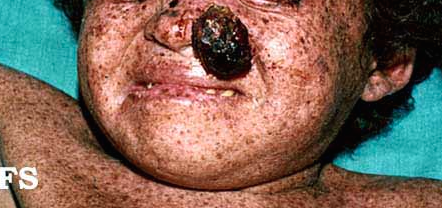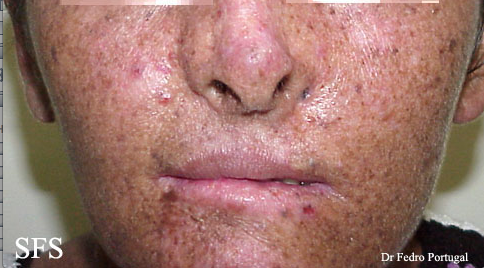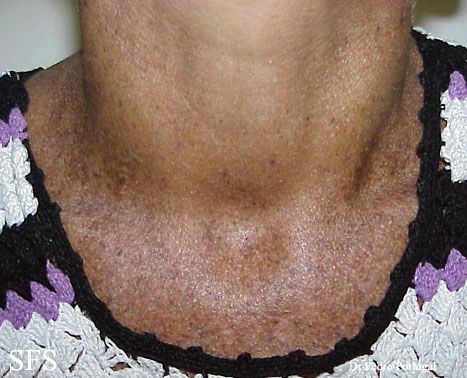Xanthelasma: Difference between revisions
No edit summary |
No edit summary |
||
| (12 intermediate revisions by 3 users not shown) | |||
| Line 1: | Line 1: | ||
__NOTOC__ | |||
{{CMG}}; {{AE}} {{JH}}. | |||
{{SK}}: Xanthelasma palpebrarum. | |||
}} | |||
{{ | |||
{{ | |||
{{ | |||
==Overview== | ==Overview== | ||
'''Xanthelasma''' (or '''xanthelasma palpebrarum''') is a sharply demarcated yellowish collection of [[cholesterol]] underneath the skin, usually on or around the [[eyelids]]. The plural is "xanthelasmata". The root of the word is from Greek xanthos, ξανθος, "yellow". | '''Xanthelasma''' (or '''xanthelasma palpebrarum''') is a sharply demarcated yellowish collection of [[cholesterol]] underneath the skin, usually on or around the [[eyelids]]. The plural is "xanthelasmata". The root of the word is from Greek xanthos, ξανθος, "yellow". | ||
Xanthelasma are distinct from [[xanthoma]] which are larger and nodular, lesions.<ref>{{cite book |author=Shields, Carol; Shields, Jerry |title=Eyelid, conjunctival, and orbital tumors: atlas and textbook |publisher=Lippincott Williams & Wilkins |location=Hagerstwon, MD |year=2008 |pages= |isbn=0-7817-7578-7 |oclc= |doi= |accessdate=}}</ref> | Xanthelasma are distinct from [[xanthoma]] which are larger and nodular, lesions.<ref>{{cite book |author=Shields, Carol; Shields, Jerry |title=Eyelid, conjunctival, and orbital tumors: atlas and textbook |publisher=Lippincott Williams & Wilkins |location=Hagerstwon, MD |year=2008 |pages= |isbn=0-7817-7578-7 |oclc= |doi= |accessdate=}}</ref> Xanthelasma are sometimes classified as a subtype of ''xanthoma''.<ref>[http://medical-dictionary.thefreedictionary.com/xanthelasma thefreedictionary.com > xanthelasma] Citing: The American Heritage Medical Dictionary Copyright 2007, 2004 and Mosby's Medical Dictionary, 8th edition. 2009</ref> | ||
==Epidemiology and Demographics== | ==Epidemiology and Demographics== | ||
A study of 12,745 people from Denmark identified xanthelasmata in 4.4% of participants aged 20-93. | |||
==Natural History, Complications, Prognosis== | ==Natural History, Complications, Prognosis== | ||
The lesions are not harmful or painful. | The lesions themselves are not harmful or painful. They may, however, be a marker of underlying [[atherosclerosis]]<ref>Christofferson et al. Xanthelasmata, arcus corneae, and ischaemic vascular disease and death in general population: prospective cohort studyBMJ 2011; 343:d5497</ref>. | ||
===Association with Atherosclerosis=== | |||
In a prospective population based cohort study (The Copenhagen City Heart Study), a total of 12,745 participants who were free of ischemic heart disease and aged 20-93 years were followed for a mean of 22 years <ref>Christofferson et al. Xanthelasmata, arcus corneae, and ischaemic vascular disease and death in general population: prospective cohort studyBMJ 2011; 343:d5497</ref>. The mulivariate adjusted risk (hazard/odds ratios adjusted for confounders including [[cholesterol]] and [[triglyceride]] concentrations) of an adverse outcome associated with the presence of xanthelasmata were as follows: | |||
*[[Myocardial infarction]]: 1.48 (95% confidence interval 1.23 to 1.79) | |||
*[[Ischemic stroke]]: 0.94 (0.73 to 1.21) | |||
* Death: 1.14 (1.04 to 1.26) for death. | |||
Thus, independent of other [[cardiac risk factors]], the presence of a xanthelasma appers to be an independent risk factor for [[atherosclerotic heart disease]]. In the same study, [[arcus senilis]] was not identified as an independent risk factor<ref>BMJ 2011; 343:d5497</ref>. | |||
===Gallery=== | |||
====Head==== | |||
<gallery> | |||
Image: Xeroderma_pigmentosum_01.png| Xeroderma pigmentosum. <SMALL><SMALL>''[http://www.atlasdermatologico.com.br/disease.jsf?diseaseId=12 With permission from Dermatology Atlas.]''<ref name="www.atlasdermatologico.com.br">{{Cite web | title = Dermatology Atlas | url = http://www.atlasdermatologico.com.br/disease.jsf?diseaseId=500> | |||
Image: Xeroderma_pigmentosum_02.png| Xeroderma pigmentosum. <SMALL><SMALL>''[http://www.atlasdermatologico.com.br/disease.jsf?diseaseId=12 With permission from Dermatology Atlas.]''<ref name="www.atlasdermatologico.com.br">{{Cite web | title = Dermatology Atlas | url = http://www.atlasdermatologico.com.br/disease.jsf?diseaseId=500> | |||
Image: Xeroderma_pigmentosum_04.png| Xeroderma pigmentosum. <SMALL><SMALL>''[http://www.atlasdermatologico.com.br/disease.jsf?diseaseId=12 With permission from Dermatology Atlas.]''<ref name="www.atlasdermatologico.com.br">{{Cite web | title = Dermatology Atlas | url = http://www.atlasdermatologico.com.br/disease.jsf?diseaseId=500> | |||
</gallery> | |||
====Extremities==== | |||
<gallery> | |||
Image: Xeroderma_pigmentosum_05.jpeg| Xeroderma pigmentosum. <SMALL><SMALL>''[http://www.atlasdermatologico.com.br/disease.jsf?diseaseId=12 With permission from Dermatology Atlas.]''<ref name="www.atlasdermatologico.com.br">{{Cite web | title = Dermatology Atlas | url = http://www.atlasdermatologico.com.br/disease.jsf?diseaseId=500> | |||
</gallery> | |||
====Trunk==== | |||
<gallery> | |||
Image: Xeroderma_pigmentosum_03.jpeg| Xeroderma pigmentosum. <SMALL><SMALL>''[http://www.atlasdermatologico.com.br/disease.jsf?diseaseId=12 With permission from Dermatology Atlas.]''<ref name="www.atlasdermatologico.com.br">{{Cite web | title = Dermatology Atlas | url = http://www.atlasdermatologico.com.br/disease.jsf?diseaseId=500> | |||
</gallery> | |||
==Differential Diagnosis of Associated Conditions== | ==Differential Diagnosis of Associated Conditions== | ||
* [[Diabetes]] | |||
* [[Hypercholesterolemia|High cholesterol levels]] (specifically [[familial hypercholesterolemia]]) | * [[Hypercholesterolemia|High cholesterol levels]] (specifically [[familial hypercholesterolemia]]) | ||
* [[LDL receptor deficiency]] | |||
* [[Menopause]] | |||
* [[Primary biliary cirrhosis]] | * [[Primary biliary cirrhosis]] | ||
* [[ | *[[Vitamin E deficiency]] (familial isolated, [[autosomal recessive]] inheritance) | ||
==Treatment== | ==Treatment== | ||
| Line 42: | Line 66: | ||
==See also== | ==See also== | ||
* [[Xanthoma]] (similar collections of cholesterol around tendons) | * [[Xanthoma]] (similar collections of cholesterol around tendons) | ||
==References== | ==References== | ||
{{Reflist|2}} | |||
{{ | |||
Latest revision as of 15:04, 20 December 2016
Editor-In-Chief: C. Michael Gibson, M.S., M.D. [1]; Associate Editor(s)-in-Chief: Jesus Rosario Hernandez, M.D. [2]. Synonyms and keywords:: Xanthelasma palpebrarum.
Overview
Xanthelasma (or xanthelasma palpebrarum) is a sharply demarcated yellowish collection of cholesterol underneath the skin, usually on or around the eyelids. The plural is "xanthelasmata". The root of the word is from Greek xanthos, ξανθος, "yellow".
Xanthelasma are distinct from xanthoma which are larger and nodular, lesions.[1] Xanthelasma are sometimes classified as a subtype of xanthoma.[2]
Epidemiology and Demographics
A study of 12,745 people from Denmark identified xanthelasmata in 4.4% of participants aged 20-93.
Natural History, Complications, Prognosis
The lesions themselves are not harmful or painful. They may, however, be a marker of underlying atherosclerosis[3].
Association with Atherosclerosis
In a prospective population based cohort study (The Copenhagen City Heart Study), a total of 12,745 participants who were free of ischemic heart disease and aged 20-93 years were followed for a mean of 22 years [4]. The mulivariate adjusted risk (hazard/odds ratios adjusted for confounders including cholesterol and triglyceride concentrations) of an adverse outcome associated with the presence of xanthelasmata were as follows:
- Myocardial infarction: 1.48 (95% confidence interval 1.23 to 1.79)
- Ischemic stroke: 0.94 (0.73 to 1.21)
- Death: 1.14 (1.04 to 1.26) for death.
Thus, independent of other cardiac risk factors, the presence of a xanthelasma appers to be an independent risk factor for atherosclerotic heart disease. In the same study, arcus senilis was not identified as an independent risk factor[5].
Gallery
Head
Extremities
Trunk
Differential Diagnosis of Associated Conditions
- Diabetes
- High cholesterol levels (specifically familial hypercholesterolemia)
- LDL receptor deficiency
- Menopause
- Primary biliary cirrhosis
- Vitamin E deficiency (familial isolated, autosomal recessive inheritance)
Treatment
These minor growths may be disfiguring and can be removed. Xanthelasmata can be removed with trichloroacetic acid peel, surgery, lasers or cryotherapy. Removal can cause scarring and pigment changes, but it is unusual after treatment with trichloroacetic acid.
See also
- Xanthoma (similar collections of cholesterol around tendons)
References
- ↑ Shields, Carol; Shields, Jerry (2008). Eyelid, conjunctival, and orbital tumors: atlas and textbook. Hagerstwon, MD: Lippincott Williams & Wilkins. ISBN 0-7817-7578-7.
- ↑ thefreedictionary.com > xanthelasma Citing: The American Heritage Medical Dictionary Copyright 2007, 2004 and Mosby's Medical Dictionary, 8th edition. 2009
- ↑ Christofferson et al. Xanthelasmata, arcus corneae, and ischaemic vascular disease and death in general population: prospective cohort studyBMJ 2011; 343:d5497
- ↑ Christofferson et al. Xanthelasmata, arcus corneae, and ischaemic vascular disease and death in general population: prospective cohort studyBMJ 2011; 343:d5497
- ↑ BMJ 2011; 343:d5497




